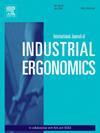The effect of elevated body mass index and sex on L5-S1 forces and lower body kinematics during symmetrical manual lifting
IF 3
2区 工程技术
Q2 ENGINEERING, INDUSTRIAL
International Journal of Industrial Ergonomics
Pub Date : 2025-05-01
DOI:10.1016/j.ergon.2025.103757
引用次数: 0
Abstract
In the U.S., 65 % of workers in the Transport, Warehousing, and Utilities sector meet the body mass index (BMI) criterion for obesity, contributing significantly to work-related musculoskeletal injuries among manual workers. However, recommended weight limits (RWL) for manual lifting tasks are based on the general population, overlooking potential adverse effects of BMI and its interaction with sex. This study examined the impact of BMI and sex on L5-S1 forces and lower body kinematics in 30 adults performing a symmetrical box-lifting task designed in accordance with the National Institute for Occupational Safety and Health (NIOSH) guidelines. L5-S1 compression and shear forces, knee and hip angles, and center of mass displacement were measured. A two-way ANOVA assessed biomechanical differences across BMI classifications and sex, while linear regressions examined BMI correlations. Results showed that BMI significantly influenced L5-S1 forces (p < 0.001), with positive relationships found between BMI and both compression (r2 = 59.4 %) and shear forces (r2 = 61.3 %). Kinematic analysis showed that obese participants flexed their hips less and had a greater center of mass displacement than non-obese participants. Female participants exhibited lower spinal loads and greater hip flexion compared to males. Notably, all obese participants exceeded the safety limits at a lifting index of 1, compared to 70 % of overweight and normal-weight participants who also surpassed these limits. These findings expand the understanding of the recommended NIOSH lifting equation (RNLE) as an ergonomic risk assessment tool by incorporating a broader BMI spectrum and its interaction with sex.
体重指数和性别的增加对对称手动举重中L5-S1力和下体运动学的影响
在美国,运输、仓储和公用事业部门65%的工人符合肥胖的体重指数(BMI)标准,这是体力劳动者中与工作相关的肌肉骨骼损伤的重要原因。然而,体力举重的推荐体重限制(RWL)是基于一般人群,忽略了BMI的潜在不利影响及其与性别的相互作用。本研究检查了BMI和性别对30名成年人进行对称提箱任务的L5-S1力和下体运动学的影响,该任务是根据国家职业安全与健康研究所(NIOSH)指南设计的。测量L5-S1压缩剪切力、膝关节和髋关节角度、质心位移。双向方差分析评估了BMI分类和性别之间的生物力学差异,而线性回归检查了BMI的相关性。结果显示,BMI对L5-S1力有显著影响(p <;0.001), BMI与压缩力(r2 = 59.4%)和剪切力(r2 = 61.3%)呈正相关。运动学分析表明,肥胖参与者的髋部屈曲比非肥胖参与者少,重心位移也比非肥胖参与者大。与男性相比,女性参与者表现出更低的脊柱负荷和更大的髋关节屈曲。值得注意的是,所有肥胖参与者的举重指数都超过了安全限制,为1,而70%的超重和正常体重参与者的举重指数也超过了安全限制。这些发现通过纳入更广泛的BMI谱及其与性别的相互作用,扩展了对推荐的NIOSH抬举方程(RNLE)作为人体工程学风险评估工具的理解。
本文章由计算机程序翻译,如有差异,请以英文原文为准。
求助全文
约1分钟内获得全文
求助全文
来源期刊
CiteScore
6.40
自引率
12.90%
发文量
110
审稿时长
56 days
期刊介绍:
The journal publishes original contributions that add to our understanding of the role of humans in today systems and the interactions thereof with various system components. The journal typically covers the following areas: industrial and occupational ergonomics, design of systems, tools and equipment, human performance measurement and modeling, human productivity, humans in technologically complex systems, and safety. The focus of the articles includes basic theoretical advances, applications, case studies, new methodologies and procedures; and empirical studies.

 求助内容:
求助内容: 应助结果提醒方式:
应助结果提醒方式:


